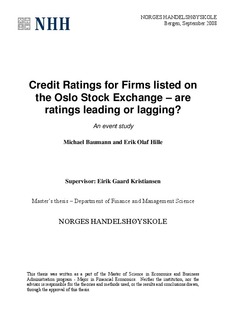Credit ratings for firms listed on the Oslo Stock Exchange – are ratings leading or lagging? : an event study
Master thesis
Permanent lenke
http://hdl.handle.net/11250/168205Utgivelsesdato
2008Metadata
Vis full innførselSamlinger
- Master Thesis [4372]
Sammendrag
This paper studies the effect of announcements by credit rating agencies (CRAs) on daily
stock returns for firms listed on the Oslo Stock Exchange (OSE) and rated by S&P, Moody's
and/or Fitch. The analysis is performed by utilizing event study methodology. Our main focus
is announcements of core credit rating changes, but we also examine watch list
announcements and aggregated announcements 1.
We find a significant negative abnormal return in the case of credit rating downgrades, while
we find no positive abnormal return in the case of upgrades. The same pattern is revealed,
although with a smaller negative abnormal return, regarding both watch list and aggregated
announcements.
The analysis is performed on several samples of sub-categories. We find that the effects of
negative announcements are more significant and larger for small firms than for large firms.
There is evidence that an unexpected rating downgrade, meaning if the issuer is not put on a
negative watch prior to the rating change, has a larger impact.
Our results indicate that CRAs, to some extent, provide the financial markets with new
information. In particularly, this applies for negative announcements. The reason for this is
possibly that good news travels faster than bad news. Issuers might publish goods news
immediately, while they are not in the same hurry with bad news and use a 3rd party like a
CRA for this purpose. Although our study shows a significant negative abnormal return on the
day of announcement, a substantial part of the total negative return occurs within a 120 day
period prior to the announcement. This indicates that most of the information provided by the
CRA is already known in the market.
We describe and discuss the most well-known points of criticism against CRAs and their role.
Many of these cause potential conflict of interest. The close relationship between the issuer
and the CRA, and the fact that the issuer pays for their own rating is one of them. Other
potential conflicts of interest are caused by the major CRAs’ dominating role in the market
and the establishment of ancillary businesses in addition to the rating business.
